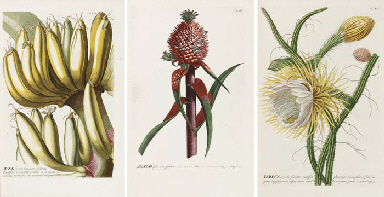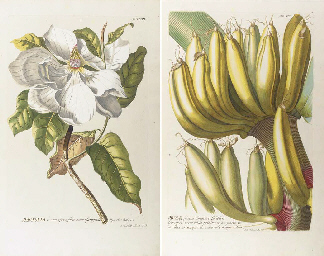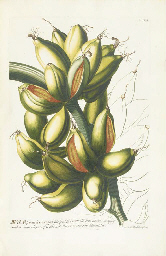TREW, Christoph Jakob Trew (1695-1769) Hortus Nitidissimis omnem per annum superbiens floribus, sive amoenissimorum florum imagines ... Der das ganze Jahr hindurch im schoensten Flohr stehende Blumen-Garten oder Abbildungen der lieblichsten Blumen. Edited by Johann Michael Seligmann (vol. I) and Adam Ludwig Wirsing (vols. II and III). Nuremberg: Fleischmann (vol. I), and Adam Ludwig Wirsing (vol. II and III), 1750-1768-1772-1786. Very rare first edition with contemporary hand-colouring of the work that Dunthorne described as ‘one of the finest records of the cultivated flowers of the period’ and Blunt (p. 166) praised as ‘one of the most decorative florilegia of the mid-eighteenth century.’ The work contains full-sized coloured illustrations of Hyacinths, Tulips, Ranunculi, Anemones, Caryophylli, Lilies, Auriculas, Roses, Narcissi, Irises, Cheiranthi, Asters, Fritillaries, and Crown Imperials. The great characteristic of the beautiful plates is the way in which the watercolour and bodycolour painting almost entirely eclipses the engraved lines. Although the work was actually started by Seligmann, the engravings were based on the collection of flower drawings owned by the botanist and bibliophile Christoph Trew, a distinguished physician of Nuremberg. Georg Ehret (1708-1770), who enjoyed Trew's patronage from 1732, and travelled widely on his behalf before settling in London in 1736, produced the designs for 40 plates. The remainder were drawn up by a team of local artists, including J.C. Keller, Professor of Drawing at Erlangen University, and the court painter Nikolaus Eisenberger. According to Stafleu the relevant text was not published simultaneously with the plates. Published between 1750 and 1773, this copy has only 114 plates on 105 sheets (numbers 6, 7, 21, 25, 41, 53 and 57 in vol. I have 2 images per sheet, as do plates 77and 91 in vol. II; the plate numbered ’60 et 61’ in vol. II contains a single image). The accompanying text to plates 1-59 (printed between 1750 and 1767) was published in 1756 and 1768 (probably actually 1767). The text for plates 60-120 (1767-1774) came out in 1772 and the text for last set of plates was published in 1786 (here missing). There is some confusion about the number of plates this work is supposed to have: Brunet V, 943 (calls for 190 plates); Dunthorne 310 (180 plates, actually 178); Great Flower Books p.78 (180 plates, plates 60/61 and 121/122 are represented by one plate each); Cleveland Collections 493 (190 plates); Nissen BBI 1995 (180 plates, 60/61 and 121/122 each on one plate, reference to Tjaden with 190 plates); Pritzel 9500 (180 plates); Stafleu and Cowan TL2 15.130 (180 plates, with reference to Tjaden with 190 plates). Volumes I and II (only, of 3) in 1 volume, folio (498 x 336mm). German and Latin text in two columns. 114 hand-coloured etched and engraved plates only on 105 leaves by J.M. Seligman, J.M. Stock and A.L. Wirsing after G.D. Ehret, G.W. Baurenfeind, B.R. and M.B. Dietschin, N.F. Eisenberger, J.C. Keller and others (vol. I: complete with plates 1-58 and no. 59 issued with second vol. and pp.88 of text, pl. 50 Corona Imperialis II trimmed at fore-edge just into image and touching caption, pl. 97 Corona Imperialis IV with folding flap at top lightly creased and 70mm closed repaired tear in blank area, I.L2 with small ink spots in margin, I.N2 with 90mm repaired marginal tear without loss, I.O2 reversed in binding verso-recto; vol. II: with 46 plates only of 61, lacking 2 letterpress text leaves pp. 1-4 at beginning of vol. II, but with pp.5-51, plate numbered ‘61 et 67’ trimmed close to caption at bottom and with the top folding flap lightly creased and very short closed repaired tear in blank area, text-leaves in vol. II browned from quire E to end and with tiny marginal worming from quire K to end, a couple of other tiny and insignificant marginal tears without loss; bound without the third volume). Contemporary calf, gilt greek-key borders to covers (rebacked p
TREW, Christoph Jakob Trew (1695-1769) Hortus Nitidissimis omnem per annum superbiens floribus, sive amoenissimorum florum imagines ... Der das ganze Jahr hindurch im schoensten Flohr stehende Blumen-Garten oder Abbildungen der lieblichsten Blumen. Edited by Johann Michael Seligmann (vol. I) and Adam Ludwig Wirsing (vols. II and III). Nuremberg: Fleischmann (vol. I), and Adam Ludwig Wirsing (vol. II and III), 1750-1768-1772-1786. Very rare first edition with contemporary hand-colouring of the work that Dunthorne described as ‘one of the finest records of the cultivated flowers of the period’ and Blunt (p. 166) praised as ‘one of the most decorative florilegia of the mid-eighteenth century.’ The work contains full-sized coloured illustrations of Hyacinths, Tulips, Ranunculi, Anemones, Caryophylli, Lilies, Auriculas, Roses, Narcissi, Irises, Cheiranthi, Asters, Fritillaries, and Crown Imperials. The great characteristic of the beautiful plates is the way in which the watercolour and bodycolour painting almost entirely eclipses the engraved lines. Although the work was actually started by Seligmann, the engravings were based on the collection of flower drawings owned by the botanist and bibliophile Christoph Trew, a distinguished physician of Nuremberg. Georg Ehret (1708-1770), who enjoyed Trew's patronage from 1732, and travelled widely on his behalf before settling in London in 1736, produced the designs for 40 plates. The remainder were drawn up by a team of local artists, including J.C. Keller, Professor of Drawing at Erlangen University, and the court painter Nikolaus Eisenberger. According to Stafleu the relevant text was not published simultaneously with the plates. Published between 1750 and 1773, this copy has only 114 plates on 105 sheets (numbers 6, 7, 21, 25, 41, 53 and 57 in vol. I have 2 images per sheet, as do plates 77and 91 in vol. II; the plate numbered ’60 et 61’ in vol. II contains a single image). The accompanying text to plates 1-59 (printed between 1750 and 1767) was published in 1756 and 1768 (probably actually 1767). The text for plates 60-120 (1767-1774) came out in 1772 and the text for last set of plates was published in 1786 (here missing). There is some confusion about the number of plates this work is supposed to have: Brunet V, 943 (calls for 190 plates); Dunthorne 310 (180 plates, actually 178); Great Flower Books p.78 (180 plates, plates 60/61 and 121/122 are represented by one plate each); Cleveland Collections 493 (190 plates); Nissen BBI 1995 (180 plates, 60/61 and 121/122 each on one plate, reference to Tjaden with 190 plates); Pritzel 9500 (180 plates); Stafleu and Cowan TL2 15.130 (180 plates, with reference to Tjaden with 190 plates). Volumes I and II (only, of 3) in 1 volume, folio (498 x 336mm). German and Latin text in two columns. 114 hand-coloured etched and engraved plates only on 105 leaves by J.M. Seligman, J.M. Stock and A.L. Wirsing after G.D. Ehret, G.W. Baurenfeind, B.R. and M.B. Dietschin, N.F. Eisenberger, J.C. Keller and others (vol. I: complete with plates 1-58 and no. 59 issued with second vol. and pp.88 of text, pl. 50 Corona Imperialis II trimmed at fore-edge just into image and touching caption, pl. 97 Corona Imperialis IV with folding flap at top lightly creased and 70mm closed repaired tear in blank area, I.L2 with small ink spots in margin, I.N2 with 90mm repaired marginal tear without loss, I.O2 reversed in binding verso-recto; vol. II: with 46 plates only of 61, lacking 2 letterpress text leaves pp. 1-4 at beginning of vol. II, but with pp.5-51, plate numbered ‘61 et 67’ trimmed close to caption at bottom and with the top folding flap lightly creased and very short closed repaired tear in blank area, text-leaves in vol. II browned from quire E to end and with tiny marginal worming from quire K to end, a couple of other tiny and insignificant marginal tears without loss; bound without the third volume). Contemporary calf, gilt greek-key borders to covers (rebacked p















Try LotSearch and its premium features for 7 days - without any costs!
Be notified automatically about new items in upcoming auctions.
Create an alert